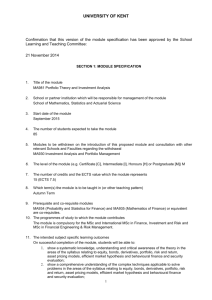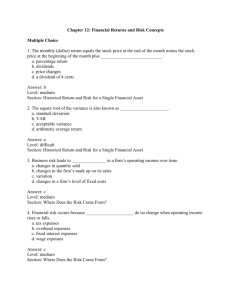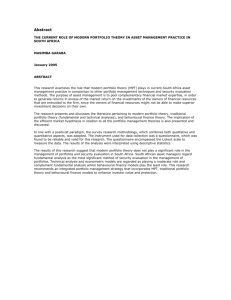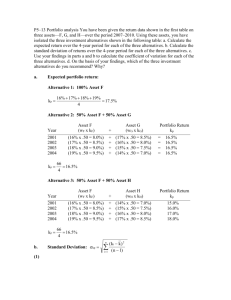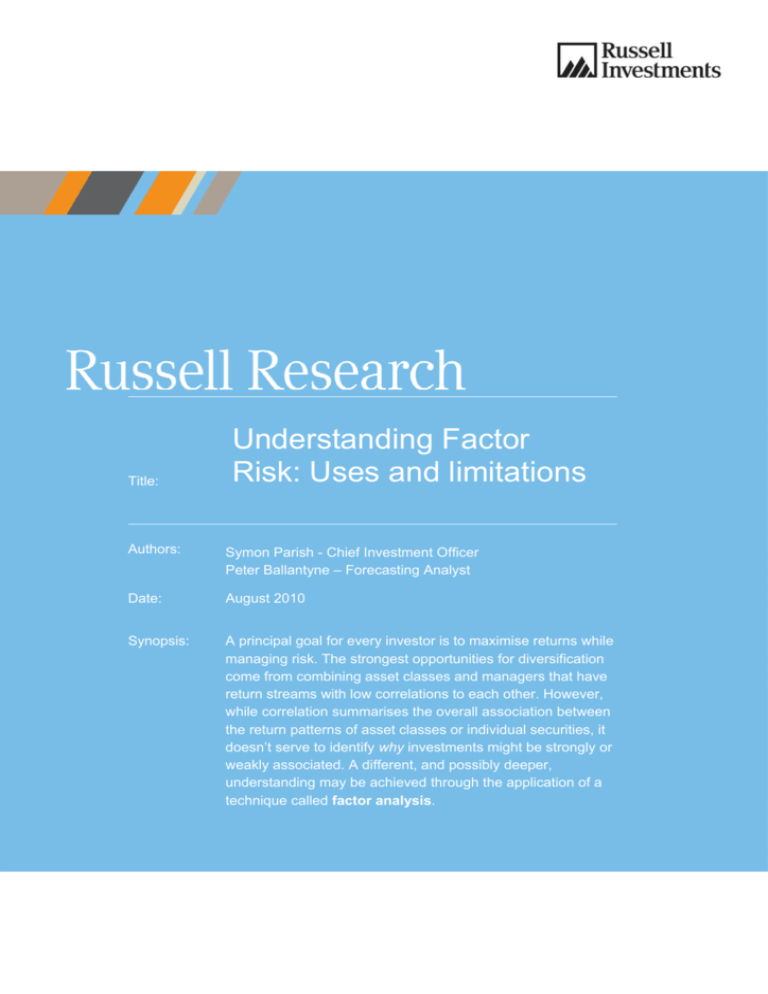
Title:
Understanding Factor
Risk: Uses and limitations
Authors:
Symon Parish - Chief Investment Officer
Peter Ballantyne – Forecasting Analyst
Date:
August 2010
Synopsis:
A principal goal for every investor is to maximise returns while
managing risk. The strongest opportunities for diversification
come from combining asset classes and managers that have
return streams with low correlations to each other. However,
while correlation summarises the overall association between
the return patterns of asset classes or individual securities, it
doesn’t serve to identify why investments might be strongly or
weakly associated. A different, and possibly deeper,
understanding may be achieved through the application of a
technique called factor analysis.
AUGUST 2010
Understanding Factor Risk:
Uses and limitations
By:
Symon Parish - Chief Investment Officer
Peter Ballantyne – Forecasting Analyst
INTRODUCTION
Central to Russell‘s investment philosophy are two major issues: diversification and
balancing risk with return. It is vital that investors understand the risk exposures in
their portfolios and manage them according to their risk appetites and tolerance
levels.
A principal goal for every investor is to maximise returns while minimising the
likelihood of not achieving the desired outcomes, or managing risk. The strongest
opportunities for diversification come from combining asset classes and managers
that have return streams with low correlations to each other. However, while
correlation summarises the overall association between the return patterns of asset
classes or individual securities, it doesn’t serve to identify why investments might be
strongly or weakly associated. A different, and possibly deeper, understanding may
be achieved through the application of a technique called factor analysis. This
complementary methodology strengthens our understanding of what underlies the
observed correlation relationships.
WHAT IS FACTOR ANALYSIS
A factor in this context is defined as any variable that contributes risk and/or return to
a particular asset or asset class. Factor analysis is then a statistical method used to
determine the sources of volatility of a particular variable. In an investment context,
this analysis might be applied to an asset class, to an investment manager’s portfolio
or to an individual security. For instance, it might be useful to know how much of the
variability in Australian equity returns can be explained by variability in GDP or CPI,
or how much of the variability in a manager’s return is due to momentum or size
factors.
The advantage of such an approach is that specific risk factors may be identified,
their impact can be quantified and they can therefore be managed. This is in contrast
to traditional approaches where the management of aggregate risk might not reveal
any substantial exposures to just one to two underlying risk factors. If a single one of
those risks were to eventuate, the impact on the portfolio could be more substantial
than an aggregate risk number might suggest.
Russell Investments // Understanding Factor Risk: Uses and limitations
Page 2
Recognising the common factors that underlie returns of different investments
provides an understanding of why they are likely to have related behaviour, and often
can suggest steps to soften the impact of surprises in over-represented underlying
factors.
While factor analysis can be quite technically demanding, this paper focuses on the
application and issues surrounding its use rather than the technicalities. The formula
below is the extent of the technical language in this document and is provided here to
give a clearer picture of the framework under which we are operating. The formula is
the basic representation of an investment’s excess return over a benchmark as a
function of its exposure to various factors plus asset specific risk.
R − r f = β1 F1 + β 2 F2 + ... + Error
In this framework:
• R is the return on the investment.
•
rf is the risk-free return. In the context of total returns this would be the riskfree rate, however, when considering active returns only, this would be the
benchmark return.
•
βi represents the exposure of the investment to some factor i.
•
Fi is the return on (or change in) factor i.
•
Error is the deviation between the actual returns and the returns explained by
the selected factors. This arises because the selected factors do not
completely explain the return on the investment. Another term for this is nonsystematic risk or asset-specific risk.
The strength of this type of analysis, however, comes not from its ability to project
returns (in fact its ability in this regard is often quite limited) but rather its ability to
identify the root sources of risk in a portfolio.
TYPES OF FACTOR RISK
This paper will assess two types of factor risk. Although the concepts behind them
are similar, they focus on two very different aspects that may impact a portfolio. The
two types of factor risk are:
•
Economic (Macro) factors
•
Fundamental factors
The diagram below gives a high-level overview of how these factors fit together.
Further detail on each factor is provided below.
Economic (Macro) factors
apply across sectors
Fundamental factors
apply within sectors
Cash
Australian
Fixed Int.
International
Fixed Int.
Australian
Equity
International
Equity
- Manager 1
- Manager 1
- Manager 1
- Manager 1
- Manager 1
- Manager 2
- Manager 2
- Manager 2
- Manager 2
- Manager 2
- Manager 3
- Manager 3
- Manager 3
- Manager 3
- Manager 3
- Manager 4
- Manager 4
- Manager 4
- Manager 4
- Manager 4
- Manager 5
- Manager 5
- Manager 5
- Manager 5
- Manager 5
Russell Investments // Understanding Factor Risk: Uses and limitations
Page 3
Economic factors (across asset classes)
Economic or Macro factors are those that, to some extent, impact the whole range of
asset classes available to an investor. For example, growth in Australian GDP might
explain a large part of the Australian equity return but explains very little of the
international fixed interest return.
Below is a list of considerations for this type of factor perspective.
• Growth in Real GDP
•
Inflation Expectations
• Change in Real GDP Growth Expectations
•
Change in Inflation Expectations
• Real Yield
•
Employment Growth
• Actual CPI Inflation
•
Growth in Real Average Weekly
Earnings
The strategic asset allocation of a portfolio is the most significant driver of its
exposure to these risk factors. However, the choice of asset segments and portfolio
construction methodology within each asset class can also play a role.
Fundamental factors (within asset classes)
Fundamental factors are those that relate to the basic characteristics of the
investments held in a portfolio, for example industry exposure, valuation ratios, credit
ratings, and so on. Unlike economic factors, which apply to total returns,
fundamental factors are usually applied to excess returns relative to the benchmark.
This is not to say that the same analysis could not be applied on an absolute basis,
but rather that within each asset class there is typically a greater focus on excess
returns.
It is important to note that the actual factors used will vary by asset class. For
instance, in an equity portfolio, it is common for the factors to include momentum and
value/growth factors. This is in contrast to fixed interest, where duration and sector
might be more important. Either way, they help to enhance an investor’s
understanding of the sources of risk in a portfolio and their possible impact on future
returns.
Some common fundamental factors include:
•
Earnings Growth
•
Industry
•
Valuation Metrics
•
Credit Quality
•
Capitalisation Size
•
Duration
•
Share Price Momentum
•
Credit Sector
•
Share Price Volatility
•
Country of Exposure
•
Financial Leverage
•
Accounting Ratios
•
Trading Activity
•
Financials
Russell Investments // Understanding Factor Risk: Uses and limitations
Page 4
Although we have made a clear distinction between economic and fundamental factors, in reality,
the distinction can become blurred. Individual managers may have higher or lower exposures to
economic factors than the benchmark. For maximum benefit, a portfolio should be examined in
aggregate across all economic and fundamental factors, however, the amount of data that would
be required to get statistically meaningful results would be difficult to obtain.
MANAGING FACTOR RISK
Motivation
There are many reasons why an investor may be interested in measuring and managing factor
risk in a portfolio. Recent history has provided us with a number of examples (set out below)
where specific factors have had a significant impact on returns across a portfolio.
1. The China Effect
The emergence of China as an economic powerhouse has impacted many different types of
assets. As well as obvious areas like Chinese equities and property, there have been flow-on
effects to commodity prices, shares of mining companies, currencies, and other Asian markets
that are linked to China through trade. Variations in market confidence about the ability of China
to continue its stellar growth rate cause volatility across all of these assets.
2. Liquidity
During the global financial crisis (GFC), the volume of market trading diminished substantially,
particularly in many credit fixed interest securities. During this time, investors developed a strong
preference for assets that were able to continue trading through this environment, that is, those
which maintained their liquidity. This created strong positive returns for a liquidity factor (and
conversely strong negative returns for an illiquidity factor). As a result, those portfolios with large
exposures to illiquid assets were impacted more heavily.
3. Leverage
One of the major outcomes of the GFC was the widespread drying up of available credit.
Companies that were highly leveraged during this time were struggling to finance their debts and,
where they did manage to do so, it was at a rate significantly higher than their existing debt. As
such, companies with high exposure to leverage performed particularly poorly during this period.
We will consider this factor in more detail later in the paper.
These examples show how much impact an intended or unintended factor exposure can have on
a portfolio. The next section explains some of the techniques that can be used to measure (and
then manage) factor risk.
Managing the Risk
The magnitude of each factor’s contribution to risk is driven by both the factor’s volatility and the
exposure of the asset to that factor. Hence, one way to manage the overall risk would be to
control the portfolio’s exposure to a particular factor. However, before making such a decision it is
important to understand what impact this could have on the portfolio’s performance. Examining
the short- and long-term patterns of factor returns enables us to make a better-informed decision
on whether an exposure to a particular factor is desirable and whether it is likely to be rewarded.
Once a decision to mitigate a factor risk has been made, a portfolio factor exposure is simply the
weighted average of the factor exposures in the underlying assets. This makes managing raw
exposures straightforward, however, as noted above, the contribution to risk is a function of both
the size and the volatility of the exposure. Even a small exposure to a factor with high volatility
can contribute significantly to the total portfolio risk.
For this reason, managing the contribution to risk from each factor is more important than
managing the factor exposures themselves. However, contribution to risk across different asset
classes cannot simply be added together to give the total risk. The total risk depends on a range
of things including exposure to the volatility of, and correlation between, the underlying factors.
Let’s consider the case of managing fundamental factors within an asset class. While it may be
possible to totally eliminate all factor exposures within an asset class, by definition this would
result in returns that (on average) represent the risk-free return. Hence, the objective of managing
factor exposures is not to totally eliminate the risk but to:
•
Understand what risks are being taken; and
•
Make a conscious decision that they are risks that are expected to directly or indirectly
provide a positive payoff.
It is important to understand that exposure to a factor may not always directly provide a positive
payoff but, rather, will allow access to other opportunities where a positive payoff is expected. For
instance, exposure to the small capitalisation factor may not generate excess returns in its own
right. However, being exposed to this factor allows an investor to generate excess returns from
stock selection within this less efficient segment of the equity market.
Example: The Impact of Leverage
Historically, exposure to the leverage factor has contributed, on average, little in terms of excess
return over the benchmark. Some may then argue that exposure to that factor on average should
be zero (or close to). That’s not to say that at certain times during the cycle an investment
manager may view the fortunes of leveraged companies to be more or less favourable and take a
position to reflect that view.
Consider the following example of an Australian equities manager. The chart below illustrates this
manager’s exposure to leverage since June 2000. The left hand axis, Exposure, is the manager’s
exposure to the leverage factor within the MSCI BARRA risk model. A positive value here
indicates that the manager has above-average exposure to leverage, while a negative number
indicates below-average exposure.
We have focused on this manager as they appear to have adopted a persistent bias towards this
factor over the last five years (as identified by the circled region in the chart). Prior to this, the
manager appears to have had no persistent exposure to the leverage factor.
Exposure to Leverage
0.6
Persistent high exposure to leverage
0.5
0.4
0.2
0.1
0
-0.1
-0.2
Source: MSCI BARRA for factor exposure
Date
Dec-09
Jun-09
Sep-09
Mar-09
Dec-08
Jun-08
Sep-08
Mar-08
Dec-07
Jun-07
Sep-07
Mar-07
Dec-06
Jun-06
Sep-06
Mar-06
Dec-05
Jun-05
Sep-05
Mar-05
Dec-04
Jun-04
Sep-04
Mar-04
Dec-03
Jun-03
Sep-03
Mar-03
Dec-02
Jun-02
Sep-02
Mar-02
Dec-01
Jun-01
Sep-01
Mar-01
Dec-00
Jun-00
-0.3
Sep-00
Exposure
0.3
Let’s now consider the characteristics of this manager under a different set of circumstances.
Instead of the persistent tilt to the leverage factor, let’s assume this exposure was zero for the
entire time period, with all other exposures left unchanged. We can then isolate the impact of the
leverage factor tilt on the portfolio’s outcomes, the results of which are shown in the chart below.
Impact of Leverage Exposure
3.00%
2.00%
1.00%
Return
0.00%
-1.00%
-2.00%
Monthly return on
leverage factor
-3.00%
Cumulative outperformance
of levered manager relative to
unlevered manager
-4.00%
Source: MSCI BARRA for factor exposure and returns
As anticipated, the impact of exposure to leverage was minimal prior to 30 June 2008. The
cumulative return over this eight-year period was just 1.2%. Exposure to leverage contributed a
minimal return premium but added an additional source of volatility. As we have seen many times
before, where there is a risk in a portfolio, there is the chance for that risk to detrimentally impact
portfolio performance. This is exactly what we witnessed in June 2008 when the availability of
credit rapidly dried up and leverage exposure became a very significant negative factor in relative
performance.
LIMITATIONS OF FACTOR ANALYSIS
Although factor analysis may be conceptually appealing and the description above may appear to
be clear cut, it is important to understand some of the shortcomings of this process:
•
In an ideal world, factors should be independent of one another. While it is possible to
derive independent factors in a technically correct fashion, this has the drawback that
such factors are likely to be intuitively meaningless. By this we mean that “independent
factor 1” will no longer map directly to (say) Real GDP growth and “independent factor 2”
will not map directly to (say) Change in Real Yield. This makes identifying and managing
specific risks more difficult.
•
Factor exposure may not be stable over time irrespective of the prevailing environment.
To this end, an economic rationale to justify certain exposures helps to improve
confidence in forward projections.
•
Factor exposure payoffs are assumed to be linear. This may not be the case in reality,
especially when changes in discount rates are involved. Nevertheless, such an
assumption is likely to provide a good approximation, unless changes in the variables are
very large.
•
Although factor analysis captures an asset’s exposure to a set of commonly known risk
factors, there often remains a significant proportion of its risk that cannot be explained by
these common factors. Although this asset-specific risk can be partially diversified away
Dec-09
Jun-09
Date
Sep-09
Mar-09
Dec-08
Jun-08
Sep-08
Mar-08
Dec-07
Jun-07
Sep-07
Mar-07
Dec-06
Jun-06
Sep-06
Mar-06
Dec-05
Jun-05
Sep-05
Mar-05
Dec-04
Jun-04
Sep-04
Mar-04
Dec-03
Jun-03
Sep-03
Mar-03
Dec-02
Jun-02
Sep-02
Mar-02
Dec-01
Jun-01
Sep-01
Mar-01
Dec-00
Jun-00
Sep-00
-5.00%
in a portfolio context, significant risk can still remain even if all factor risks could be
eliminated.
•
Where the available data are limited there is a risk of capturing idiosyncrasies in the
specific data set rather than genuine long-term characteristics. We must resist the
temptation to use an increasingly large number of variables to explain the available data.
•
In an investment world where asset values are largely driven by the future expectations of
market participants, factor analysis should be based on innovations in the factors (that is,
changes in market expectations). Unfortunately, markets expectations are not always
directly observable. For example, equity assets may be driven by changes in market
expectations of GDP growth, however, expectations of GDP growth are not directly
observable. In these cases it may be possible to identify some proxy for the innovation.
CONCLUSIONS
The key message from this paper is that, under the right circumstances, any risk can cause
significant harm to a portfolio. To compensate for that risk, we should always demand a risk
premium for taking on the risk, even if its volatility has been historically low. This premium can be
achieved in one of two ways. It can be earned from excess returns generated by the factor tilt
itself or from returns that are facilitated by the tilt. As we showed with leverage, the historical
premium for taking on leverage risk was essentially zero, yet during the GFC this was a risk that
caused significant damage to certain portfolios.
Factor analysis is one means of identifying the risk exposures in a portfolio. It helps to ensure that
each risk exposure is generating a sufficient risk premium to compensate for the risk being taken.
Where a portfolio exhibits an exposure to a factor with an insufficient return premium, there is an
argument for neutralising the exposure. This can be achieved by taking a position in an asset (or
asset class) with an offsetting exposure to the particular risk factor.
Factor analysis, however, is not infallible. Factor exposures and volatilities can change over time.
There may also be extended periods where that factor over or under performs even where a
factor has a long-term premium of zero. Finally, despite a risk exposure in need of mitigating
being identified, there may not be an appropriate asset class to offset the risk.
Ultimately, even if a risk is identified and a decision is made to take no action, this is still a
valuable process to undertake. It is always worthwhile for investors to understand what risks exist
in their portfolios so that they can make informed decisions regarding those risks.
RELATED READING
Warren, G. (2008), “Diversification with Attitude – Part A: Improving Your Asset Class Mix”,
Russell Research Report (August)
Disclaimer
This document is issued by Russell
Investment Management Pty Ltd
ABN53 068 338 974, AFS Licence
247185 (RIM). It provides general
information for wholesale investors only
and has not been prepared having
regard to your objectives, financial
situation or needs. Before making an
investment decision, you need to
consider whether this information is
appropriate to your objectives, financial
situation or needs. This information has
been compiled from sources considered
to be reliable, but is not guaranteed.
Past performance is not a reliable
indicator of future performance.
Nothing contained in this material is
intended to constitute legal, tax,
securities, or investment advice, nor an
opinion regarding the appropriateness of
any investment, nor a solicitation of any
type. Copyright © 2010 Russell
Investments. All rights reserved. This
material is proprietary and may not be
reproduced, transferred, or distributed in
any form without prior written permission
from RIM.
First used: August 2010
MKT 2629 0710
For more information
about Russell:
Call:
+61 2 9229 5111
Visit:
www.russell.com.au/institutional
ABOUT RUSSELL INVESTMENTS
Russell Investments improves financial security for people
by providing strategic investment advice, world class
implementation, state-of-the-art performance benchmarks,
and a range of objectively researched, institutional-quality
investments.
Russell serves individual, institutional and adviser clients in
more than 47 countries.
Founded in 1936, Russell is a subsidiary of Northwestern
Mutual. The firm, headquartered in Tacoma, Washington, US,
has principal offices in Amsterdam, Auckland, Hong Kong,
Johannesburg, London, Melbourne, New York, Paris, San
Francisco, Singapore, Sydney, Tokyo and Toronto.





